Whether you missed it or were in the thick of it – including water cannon competitions – it’s fun to see all the imaginative and patriotic decorations of boats on Pawtuckaway for the annual boat parade all in one place. Here and in the permanent Photo Gallery, you can feast your eyes. This is truly a creative bunch!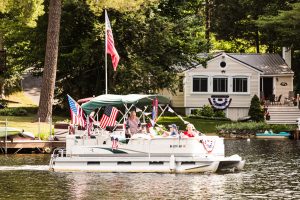
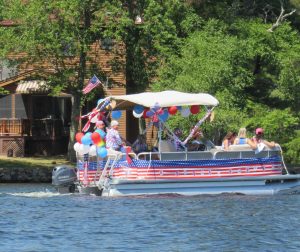
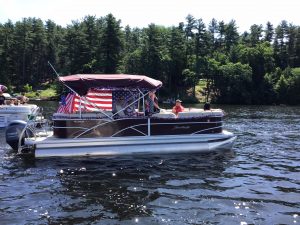
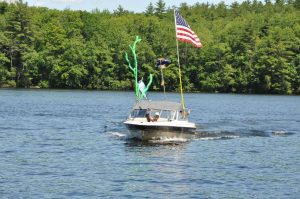
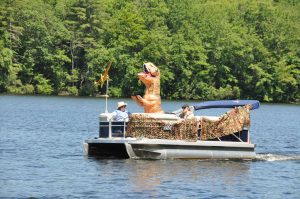
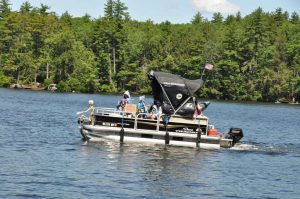
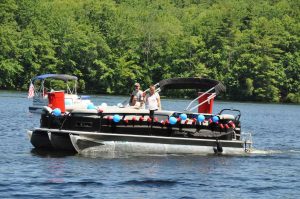
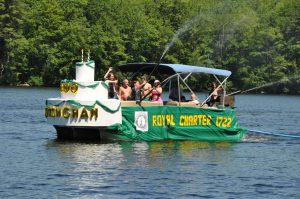
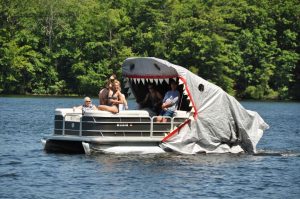
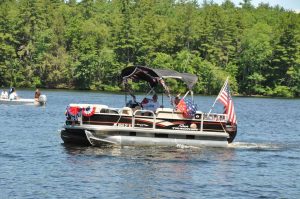
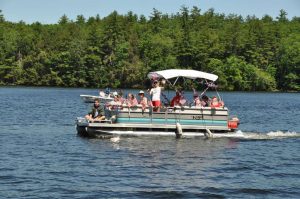
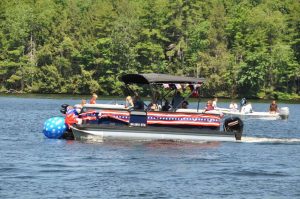
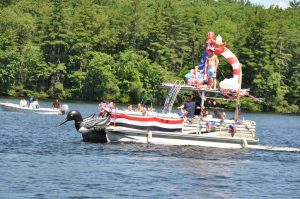
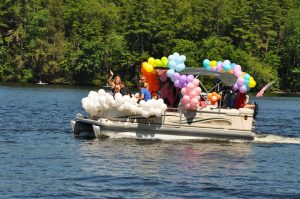
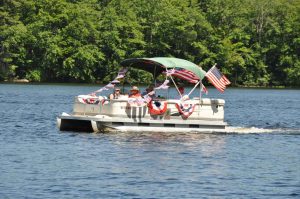

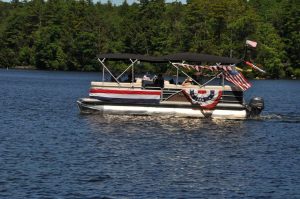
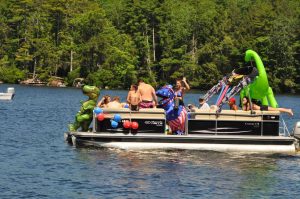
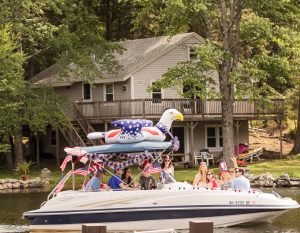
Stewards of the Lake – Supporters of the PLIA
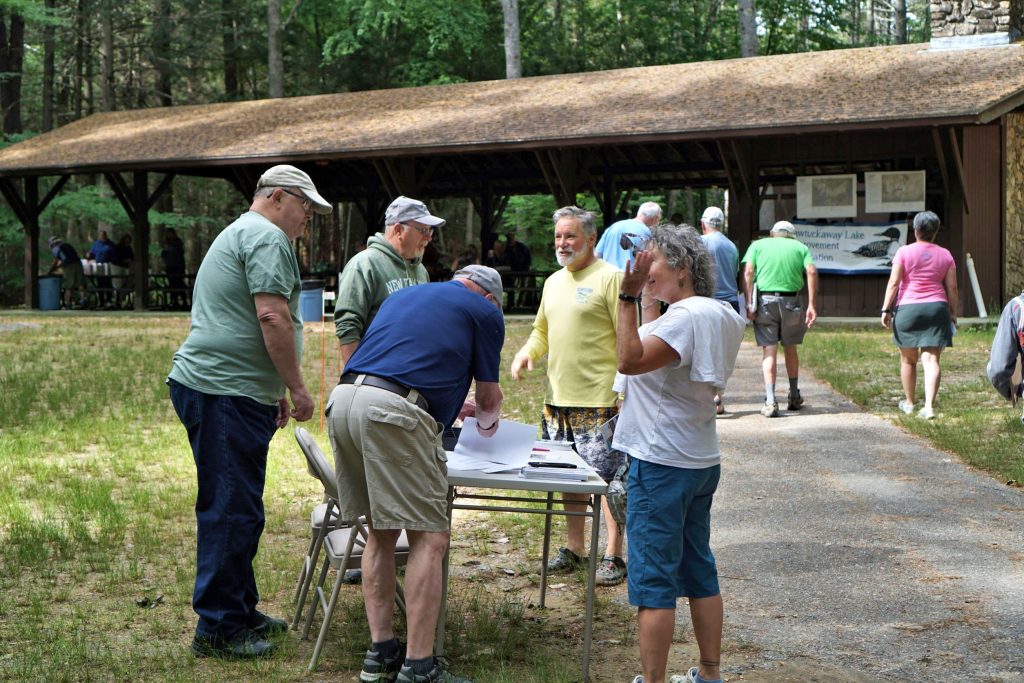 The PLIA Annual Meeting held at the Pawtuckaway State Park Pavilion on June 11
The PLIA Annual Meeting held at the Pawtuckaway State Park Pavilion on June 11 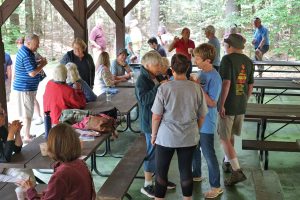 attracted a crowd of over 80 people. The weather was fine, spirits were high, and attention was focused on issues of importance to wildlife and recreation on the lake.
attracted a crowd of over 80 people. The weather was fine, spirits were high, and attention was focused on issues of importance to wildlife and recreation on the lake.
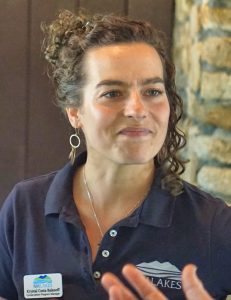 The featured speaker, Krystal Costa Balanoff of NH LAKES, addressed the gathering on the topic of making shoreline properties lake friendly. She stressed the harm caused by runoff of polluted water into the lake and ways to mitigate such damage through landscaping and other practices. NH LAKES offers a program called LakeSmart designed to help property owners assess conditions on their property, suggesting methods to improve their land and its impact on the health of adjacent water. The program is free of charge and completely confidential. To learn more, click here.
The featured speaker, Krystal Costa Balanoff of NH LAKES, addressed the gathering on the topic of making shoreline properties lake friendly. She stressed the harm caused by runoff of polluted water into the lake and ways to mitigate such damage through landscaping and other practices. NH LAKES offers a program called LakeSmart designed to help property owners assess conditions on their property, suggesting methods to improve their land and its impact on the health of adjacent water. The program is free of charge and completely confidential. To learn more, click here.
Reports on the PLIA’s programs were given, 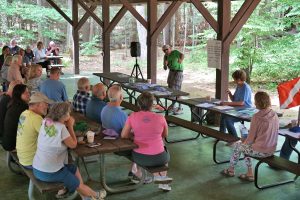 updating members on the status of various issues related to the lake and its community.
updating members on the status of various issues related to the lake and its community.
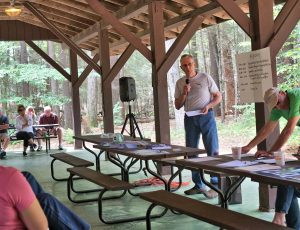
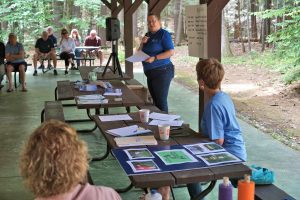

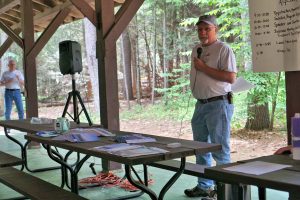 A fundraising effort initiated by one of our youngest members was also introduced.
A fundraising effort initiated by one of our youngest members was also introduced.
The annual Local Hero award was presented to Jamie Burleigh for his tireless work and countless volunteer hours extracting milfoil from the lake
for his tireless work and countless volunteer hours extracting milfoil from the lake 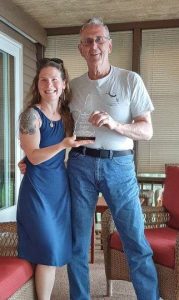 with his diving partner Sarah Patey. Neil detailed the efforts of this exceptional team of volunteer divers over the past several years, starting as early as April with ice still on the lake until October amid the lake drawdown. Because she could not be present at the meeting, Sarah was presented with her award at the home of Milfoil Team Chair Neil Santos. Thank you, Sarah and Jamie!
with his diving partner Sarah Patey. Neil detailed the efforts of this exceptional team of volunteer divers over the past several years, starting as early as April with ice still on the lake until October amid the lake drawdown. Because she could not be present at the meeting, Sarah was presented with her award at the home of Milfoil Team Chair Neil Santos. Thank you, Sarah and Jamie!
Folks who attended the Annual Meeting came away with a fresh sense of enthusiasm for the work of the PLIA and their part in that work as supporters and volunteers. Below are photos of this wonderful crowd! See you on the lake!
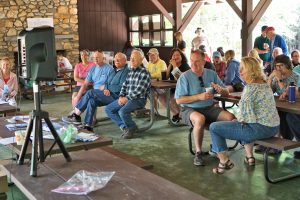
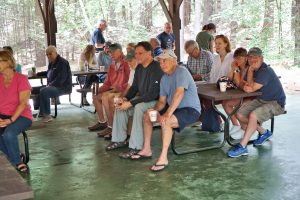
Annual Meeting is Right Around the Corner!
ANNUAL MEETING – LET’S DO IT AGAIN!
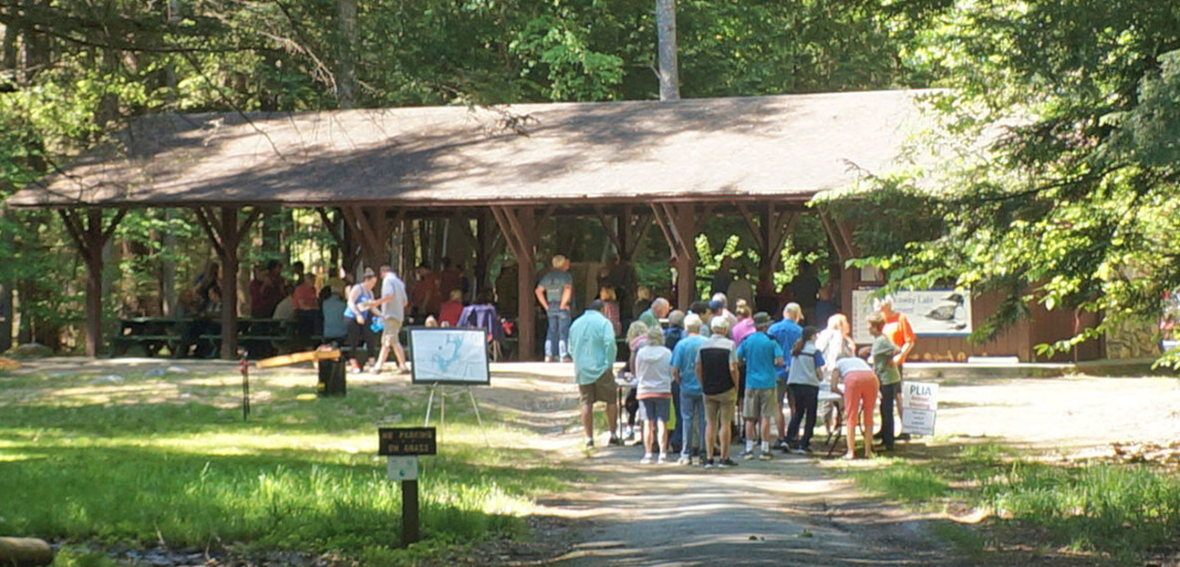 We are returning to the Pavilion at the State Park for our annual gathering of members and friends, but we are also returning to our old meeting time, at the beginning of June. This will help us kick off the new season, while giving us the chance to review our work from last year. As before, entry to the State Park will be FREE to all comers!
We are returning to the Pavilion at the State Park for our annual gathering of members and friends, but we are also returning to our old meeting time, at the beginning of June. This will help us kick off the new season, while giving us the chance to review our work from last year. As before, entry to the State Park will be FREE to all comers!
We have changed our lineup for the meeting:
SATURDAY, JUNE 11, 2022 9:30 AM
AGENDA
9:30 – 10:00 Registration, Membership, Refreshments
10:00 – 10:15 Socialize, Program Displays, Hat & T-Shirt Sales
10:15 – 11:00 Speaker and Questions
11:00 – 11:45 Business Meeting, Vote for Board Members, Treasurer’s Report, Program Reports
11:40 – 11:45 Local Hero Award
11:45 Wrap Up
The map to the right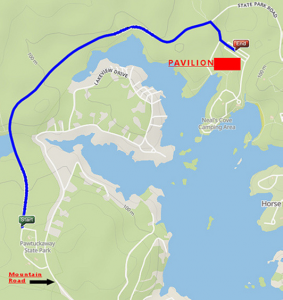 shows the State Park and the Pavilion. The sign at the intersection of Route 156 and Mountain Road indicates that the State Park entrance is two miles down Mountain Road. Drive into the Park to the entry booth and let the Park staff know you are going to the PLIA Annual Meeting at the Pavilion. Entrance will be free of charge. Continue down the Park road until you see a sign for the Pavilion to the right, then take your next left into the parking lot. We are excited about our program this year and we look forward to seeing members and supporters. You should not hesitate to bring a neighbor or friend to share with them all that this organization does for the lake. And welcome!
shows the State Park and the Pavilion. The sign at the intersection of Route 156 and Mountain Road indicates that the State Park entrance is two miles down Mountain Road. Drive into the Park to the entry booth and let the Park staff know you are going to the PLIA Annual Meeting at the Pavilion. Entrance will be free of charge. Continue down the Park road until you see a sign for the Pavilion to the right, then take your next left into the parking lot. We are excited about our program this year and we look forward to seeing members and supporters. You should not hesitate to bring a neighbor or friend to share with them all that this organization does for the lake. And welcome!
Lake Hosting – All You Need to Know
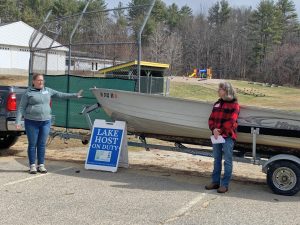
PawPrints Now Available Online
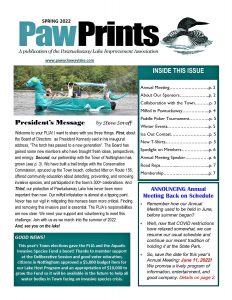 The print version of our annual newsletter, Pawprints, has been mailed to members and friends of the PLIA. Now it is also available electronically – and in color! Just click here: PawPrints 2022.
The print version of our annual newsletter, Pawprints, has been mailed to members and friends of the PLIA. Now it is also available electronically – and in color! Just click here: PawPrints 2022.
We hope you will enjoy reading news of our organization and plans for the upcoming year. There is also information about our Annual Meeting in June, which will once again be held at Pawtuckaway State Park.
As always, there is a reminder to renew your membership in the PLIA or if you haven’t joined us already, to become a member! We look forward to seeing you at the Park and on the lake…
PLIA Tackles Nottingham Town Beach Clean Up
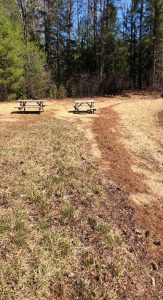
On April 16, 2022, a crew of PLIA members volunteered to take on the Town beach as a service 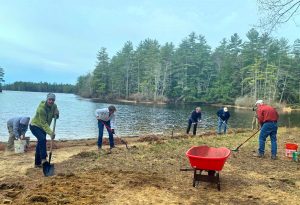 project for Nottingham Clean Up Day. They brought their tools, rolled up their sleeves, and got to work on reversing the neglect of five years without maintenance. From 8:00 – 11:30 AM on April 16th, volunteers wielded picks, hoes, rakes, saws, loppers, and wheelbarrows in an effort to reclaim the sand that had been taken over by grass and bushes.
project for Nottingham Clean Up Day. They brought their tools, rolled up their sleeves, and got to work on reversing the neglect of five years without maintenance. From 8:00 – 11:30 AM on April 16th, volunteers wielded picks, hoes, rakes, saws, loppers, and wheelbarrows in an effort to reclaim the sand that had been taken over by grass and bushes.
It turned out to be a more challenging task than anyone had anticipated. The grass had roots that 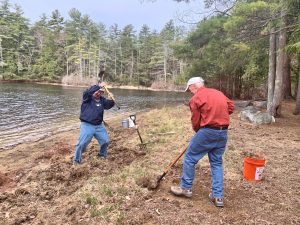 were holding together a lot of soil on top of the underlying sand. The bushes had roots that were long and tough and resistant to being pulled up.
were holding together a lot of soil on top of the underlying sand. The bushes had roots that were long and tough and resistant to being pulled up.
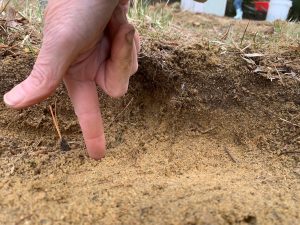 One observant worker noticed the layering of soil and sand under the grass. The top part was darker brown and clearly the product of decomposing plant matter over a number of years, while the sand beneath remained a lighter inorganic shade. Very dramatic! However, it made the group’s job clearer – remove as much organic matter as possible and expose the sand to the surface rays of the sun. Backbreaking but rewarding work.
One observant worker noticed the layering of soil and sand under the grass. The top part was darker brown and clearly the product of decomposing plant matter over a number of years, while the sand beneath remained a lighter inorganic shade. Very dramatic! However, it made the group’s job clearer – remove as much organic matter as possible and expose the sand to the surface rays of the sun. Backbreaking but rewarding work.
As for the bushes, well, they often required a reciprocating saw to trim their branches and 
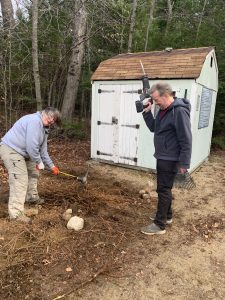 a lopper to tame their roots. Thank goodness for the wheelbarrow to transport the discarded plant matter into the woods where its decomposition would benefit the trees and wildlife.
a lopper to tame their roots. Thank goodness for the wheelbarrow to transport the discarded plant matter into the woods where its decomposition would benefit the trees and wildlife.
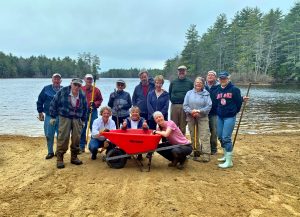 All in all, a successful morning amidst beautiful scenery. Fresh air, a breeze to blow away the bugs, good company, plenty of exercise. And Pawtuckaway Lake looks good from every angle!
All in all, a successful morning amidst beautiful scenery. Fresh air, a breeze to blow away the bugs, good company, plenty of exercise. And Pawtuckaway Lake looks good from every angle! 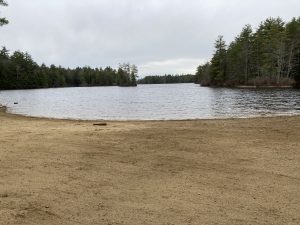
Now, so does the Town beach!
COMMUNITY VOLUNTEER TRAINING WORKSHOPS
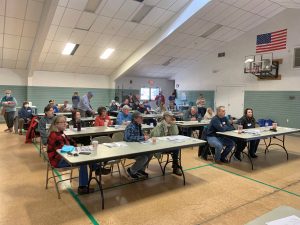 On April 3, 2022, at the Town of Nottingham Community Center, the PLIA held
On April 3, 2022, at the Town of Nottingham Community Center, the PLIA held 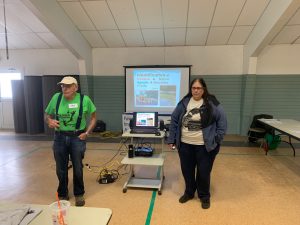 an Aquatic Invasive Species Training. They called in experts and tapped their Program Chairs to offer free Community Workshops to anyone in Nottingham interested in protecting a local water body from invasive species. For those who were unable to attend or attendees who wish to review some of the materials presented, there are links in the article below to each Power Point presentation.
an Aquatic Invasive Species Training. They called in experts and tapped their Program Chairs to offer free Community Workshops to anyone in Nottingham interested in protecting a local water body from invasive species. For those who were unable to attend or attendees who wish to review some of the materials presented, there are links in the article below to each Power Point presentation.
 First: Member Therese Thompson provided instruction on identifying aquatic invasive species in or around a lake or pond. Her lecture was very comprehensive, covering both native and non-native plants. It included pointers on how to recognize and distinguish between both, which can sometime be a difficult challenge. She highlighted the invasive plants that have been found in and around Pawtuckaway. In particular, she urges everyone to pay special attention to the last slide in her show, that has links to resources to help with identifications: Aquatic Invasives
First: Member Therese Thompson provided instruction on identifying aquatic invasive species in or around a lake or pond. Her lecture was very comprehensive, covering both native and non-native plants. It included pointers on how to recognize and distinguish between both, which can sometime be a difficult challenge. She highlighted the invasive plants that have been found in and around Pawtuckaway. In particular, she urges everyone to pay special attention to the last slide in her show, that has links to resources to help with identifications: Aquatic Invasives
Next: Lake Host Coordinator Dee Decker
Lake Host Coordinator Dee Decker  explained NH LAKES’ Lake Host Program and the PLIA’s participation in it. Her presentation included instruction on inspecting boats and trailers to detect invasive “hitchhikers” before they enter a water body, plus how to clean, drain, and dry watercraft to avoid the spread of these invaders. When the gathering moved outside, Lake Host Manager Mary
explained NH LAKES’ Lake Host Program and the PLIA’s participation in it. Her presentation included instruction on inspecting boats and trailers to detect invasive “hitchhikers” before they enter a water body, plus how to clean, drain, and dry watercraft to avoid the spread of these invaders. When the gathering moved outside, Lake Host Manager Mary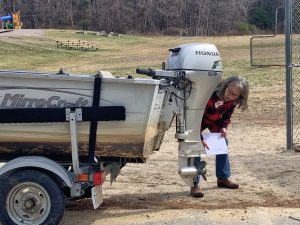 Hervey assisted Dee to demonstrate actual boat and trailer inspection protocols. They also offered advice about courtesy, efficiency, and education when talking to boaters about these inspections: Lake Host
Hervey assisted Dee to demonstrate actual boat and trailer inspection protocols. They also offered advice about courtesy, efficiency, and education when talking to boaters about these inspections: Lake Host
Then: Milfoil Team Chair Neil Santos demonstrated how milfoil has spread in
Milfoil Team Chair Neil Santos demonstrated how milfoil has spread in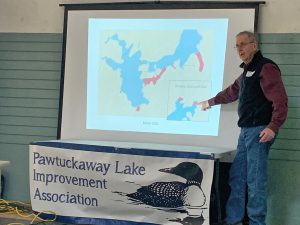 Pawtuckaway Lake since 2015. He explained why a milfoil infestation is harmful and how his team searches for and removes this weed, one of the most pervasive of the invasives. He reminded people to contact him, Dee Decker, or Steve Soreff if they saw a suspicious growth so it could be located and identified. There are two Power Point presentations that illustrate his talk: Milfoil Procedures and PLIA Milfoil Team
Pawtuckaway Lake since 2015. He explained why a milfoil infestation is harmful and how his team searches for and removes this weed, one of the most pervasive of the invasives. He reminded people to contact him, Dee Decker, or Steve Soreff if they saw a suspicious growth so it could be located and identified. There are two Power Point presentations that illustrate his talk: Milfoil Procedures and PLIA Milfoil Team
Finally: Chair Pete Wawrzonek introduced the PLIA’s Road Representative (or “Road Rep”) Program that enables residents and members to learn about the organization and its activities and encourages newcomers to join: Road Reps
 Last but not Least: Attendees enjoyed a complimentary pizza lunch and a selection of free T-shirts to take home.
Last but not Least: Attendees enjoyed a complimentary pizza lunch and a selection of free T-shirts to take home.
We have learned much over the years with our experience on Pawtuckaway and are happy to share it with the entire community.
Cornhole Tournament Has Been Postponed
CORNHOLE RESCHEDULED – Mother Nature has forced us to postpone our Tournament!
The organizers of the PLIA’s first Cornhole Tournament on the Ice have been watching the weather forecasts and have concluded that extreme weather will make the original date of the event too dangerous. Blizzards are not friendly! Sunny skies are more to our liking: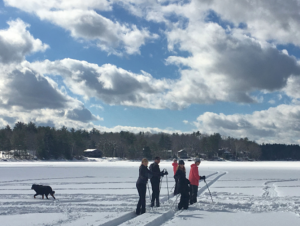
PLIA Volunteers – Defenders of the Lake
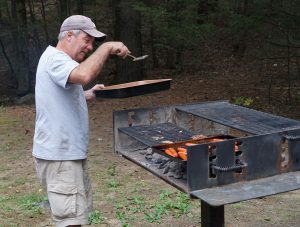 On Sunday, September 26, the PLIA celebrated the accomplishments of its
On Sunday, September 26, the PLIA celebrated the accomplishments of its volunteers at a cookout held at the Pawtuckaway State Park Pavilion. We are grateful to Park officials for making the Pavilion available for this event – a beautiful setting, a beautiful day, with beautiful people! Last year, COVID concerns prevented us from holding this annual celebration. That made us doubly lucky that we could gather once again in person to thank the folks who actually bring the PLIA’s mission to life.
volunteers at a cookout held at the Pawtuckaway State Park Pavilion. We are grateful to Park officials for making the Pavilion available for this event – a beautiful setting, a beautiful day, with beautiful people! Last year, COVID concerns prevented us from holding this annual celebration. That made us doubly lucky that we could gather once again in person to thank the folks who actually bring the PLIA’s mission to life.
 As the saying goes, volunteers are unpaid not because they are worthless, but
As the saying goes, volunteers are unpaid not because they are worthless, but  because they are priceless! For the PLIA, the important job of keeping the lake healthy and safe would be impossible without our tireless, and yes – enthusiastic – volunteers. Below are some of the things they do:
because they are priceless! For the PLIA, the important job of keeping the lake healthy and safe would be impossible without our tireless, and yes – enthusiastic – volunteers. Below are some of the things they do:
- Educate boaters about the dangers of aquatic invasive species and how to prevent their spread, then
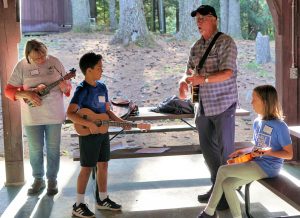 perform courtesy
perform courtesy 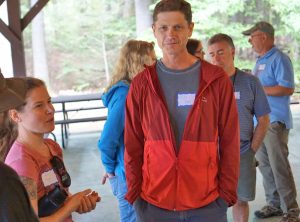 boat and trailer inspections
boat and trailer inspections - Search the lake all season for evidence of invasives like purple loosestrife, phragmites, variable milfoil, and Chinese mystery snails
- Mark plants that are located and remove them; with Chinese mystery snails, extract them immediately
- Take water samples from the lake and tributaries for analysis in the State’s DES labs
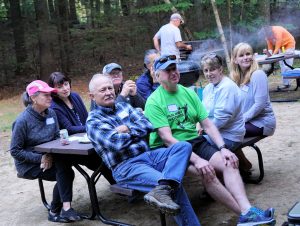
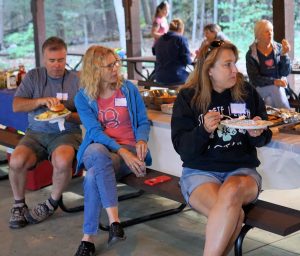 Pick up trash along a local roadside strip three times a year
Pick up trash along a local roadside strip three times a year- Monitor lake islands to prevent fires and keep them free of litter throughout the season
- Collaborate with government and conservation agencies to promote these efforts
- Inform the public about best practices for maintaining a healthy lake for recreational use and the benefit of wildlife
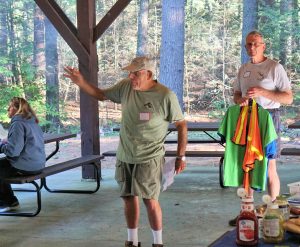 Anyone can be a volunteer, in whatever capacity and however your schedule
Anyone can be a volunteer, in whatever capacity and however your schedule 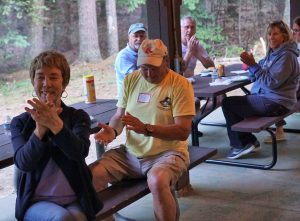 permits! If you would like to join this merry band, please contact our President Steve Soreff at soreffs15@aol.com; 603 895-6120 (H) or 603 568-3202(C). We hope to post photos of you at the cookout next year. And meanwhile, see you on the lake!
permits! If you would like to join this merry band, please contact our President Steve Soreff at soreffs15@aol.com; 603 895-6120 (H) or 603 568-3202(C). We hope to post photos of you at the cookout next year. And meanwhile, see you on the lake!